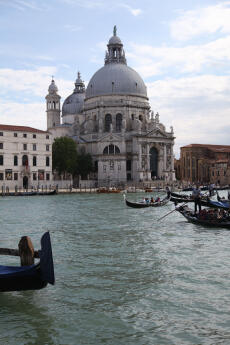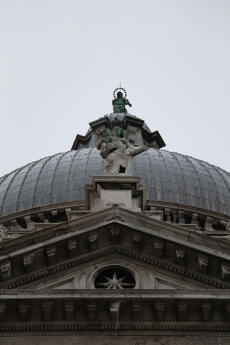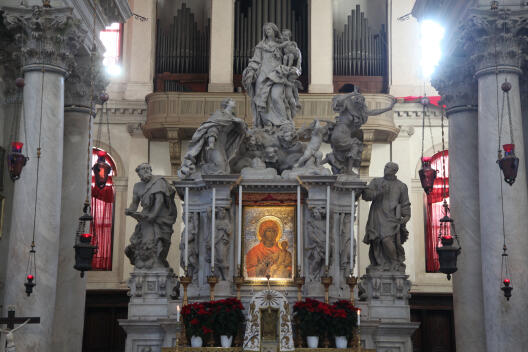God’s Punishment – God’s Mercy
Dealing architecturally and pictorially with the Great Plague in Venice of 1629-31
By art historian Jens Niebaum
Religion played a Janus-faced role in how society dealt with epidemics in the pre-modern era. On the one hand, it was used to provide explanations for the occurrence of the epidemic, which barely seemed conceivable other than as God’s punishment; this explanation accorded with the Biblical account (2 Sam. 2; 1 Chr. 21), which relates how God sanctioned King David’s arrogance by bringing a three-day plague upon Israel. In the early modern period, it tended to be everyday vices such as profligacy, ‘licentiousness’, and (a classic) a lack of Sunday sanctification that were identified as causes of God’s “righteous anger” and that were eloquently lamented in penitential sermons and treatises. As the official and church pronouncements leave no doubt, appeasing the angry Lord is therefore the only way to overcome the evil permanently – irrespective of the fact that an increasingly diverse set of measures was being developed to do as much as possible to contain the spread of the plague (see, for example, the contributions to the dossier “Precautions and Rules”).
On the other, besides the justification for punishment (which at least institutional textual sources did not doubt), religion, with the promise constitutive of the Christian faith of heavenly salvation and divine mercy, also provided a genuine resource of hope – hope for survival and recovery for some, or at least the hope that others would be spared damnation and purgatory (see also the contribution by Martina Wagner-Egelhaaf). How was this hope for mercy in the present and for protection in the future articulated in architectural and pictorial testimonies, as well as in how these testimonies were dealt with? As an example, let us look at how the devastating plague epi-demic in Venice, where between 1629 and 1631 around 42,000 inhabitants, almost a third of the population, fell victim to the epidemic, was dealt with.
Immediately after the outbreak of the epidemic, a wide range of liturgical and paraliturgical formats were activated to obtain the assistance of God and his saints, including expositions and adorations of the Eucharist in the cathedral and in the ‘state church’ of San Marco, fasting and penitential days, and solemn prayers at the bones of the plague saint Roch and Blessed Lorenzo Giustiniani, the first patriarch of Venice, whose relics were also taken around in processions. In accordance with Catholic doctrine, they were implored to bring their intercession, which had already proven effective many times, for the preservation of the city and the liberation of the state from disease before God – in return, the Blessed was promised that work would be done for his future canonization in Rome. In order to ensure the spiritual care of the people on earth, the patriarch of the Serenissima obliged the local clergy to assist the plague sufferers and not to abandon their own congregation – on pain of having their benefices withdrawn. The shining example was Milan’s Archbishop Charles Borromeo, who during the catastrophic epidemic in his city in 1576 had personally administered the sacrament to the dying in the hospital. The scene, which shows the cardinal as an indomitable hero, usually in episcopal regalia among the sick and dying, was not depicted again and again for nothing: it showed how seriously the clergy had tak-en their task as pastors since the Reform Council of Trent (see for a related example the contribution by Eva Krems in the dossier ‘[In]visibilities’).
The most enduring measure against the plague, however, was the famous vow in 1630 by which the Doge, on behalf of the government of the Serenissima, promised to build Our Lady a mag-nificent church (magnifica e con pompa) and to visit her in solemn procession every year on the return of the day on which the city would be declared plague-free. This is an explicit reference to the experience of the last great epidemic of 1576, which died out after a vow was made to build a church dedicated to the Saviour. On the other hand, reference was also being made to the special protective relationship (tried and tested since the founding of the city on Annunciation Day in 421) of the Madonna to Venice, which conceived of itself as a daughter of Mary. Accordingly, Annunciation Day in 1631 was chosen as the day for the laying of the foundation stone (even if the event had to be postponed for a week because of rain). Such an act of ‘appropriation’ of Mary by the respective rulers was anything but unusual in Catholic countries; while serving to legitimize and stabilize state authority, it was also based on a genuinely religious resource, as Mary had for centuries been ascribed the role of the most important intercessor, indeed the co-redemptrix, for whose praise an extensive repertory of forms of piety and veneration was available.

Built between 1630 and 1687 on designs by the young architect Baldassare Longhena, the church is dedicated to the Madonna della Salute, which can mean both physical health and spiritual salvation in equal measure. Situated in an incomparable position on the headland between Canale della Giudecca and Canal Grande, it dominates the entrance to Venice’s most important waterway while also accompanying it through the ‘emission’ of several spatial axes (Fig. 1). As one of the city’s most famous and distinctive landmarks, it is a reminder of the severe punishment visited on the city, but above all a triumphant monument to the help that the community finally regained thanks to Mary’s intercession. It is also a monument to Venice’s special relationship with its chief intercessor and thus to the city’s privileged access to God, whom it can ultimately rely upon even in extreme hardship. As a foundation of the government and through the annual procession that is held with great pomp, the church naturally plays a strong stabilizing role in terms of rule due to the success associated with the vow. But it would be wrong to reduce its function to this political-instrumental aspect. This is made clear by the fact alone that there developed in the years after 1630 and into the 19th century a cult of the Madonna della Salute in numerous other churches in Venice and the Veneto, as shown in the founding of confraternities, the endowment of ex voti, and even the construction of altars to this patrocinium. The state emerges here as a sacred community that ultimately offers all subjects a perspective of salvation, and unites them under the protection of the dedicatee.
In a memorandum of 1631, Longhena justifies the choice of the “forma di rottonda” (the “round form”; here, the form of an equilateral octagon approximating the circle) by pointing to the novelty of such a church building in Venice, something that many Venetians had desired, but also to its similarity in form to a crown, since it was dedicated to Our Lady (“per esser dedicata a essa Vergine”). We do not know whether it was actually the rather abstract similarity of the building to a crown that shaped the design, or whether the decisive factor was not the interest in having a centred monumental building. Typological parallels to several churches in Upper Italy seem to speak more in favour of the latter. What is important, however, is that Longhena assumed that he could make his design more plausible to his clients by referring to the attribute of the Queen of Heaven, and this argument, while not unprecedented in Venice, can hardly be seen independently of the reason for the church’s origin: Mary was invoked as the Queen of Heaven in the Venetian litany sung during the plague processions, and the ceremonies of taking vows and lay-ing the foundation stone for the Votive Church also ended with the singing of the Salve Regina. The supplication rich in tradition invokes Mary as “Queen, Mother of Mercy” (“Regina, Mater misericordiae”) – as Queen of Heaven, she is especially empowered to intercede and is thus the most important access to the hope for divine mercy.

Mary as Queen of Heaven therefore also features prominently in the new Marian church. She appears with her child on her right arm on the top of the central pediment (Fig. 2). All around the building, the voids of the upper arcade and the fronts of the neighbouring chapels show warrior saints as well as prophets and Old Testament types of Mary, including Esther and Judith, who had rescued their people from existential danger; below her, sibyls and evangelists point to the advent and work of the Saviour. But one central element is missing today: the arched field of the huge portal under the statue of Mary was once occupied by a large Lion of Saint Mark, the most important symbol of the Serenissima. When the main portal was opened on the occasion of the annual memorial procession to allow the Doge and the other representatives of the community to enter the church, the Lion, just above the threshold, established the connection to the addressee of their intercession and thus to the occasion of the building’s foundation. The lanterns of the two domes above the main room and the sanctuary also emphasize Venice’s privileged relationship with the Madonna: on the large dome is Mary as the Immaculata with a wreath of stars above the crescent moon; corresponding to her on the smaller dome is a statue of the most important patron saint of the city, Saint Mark.
Among the most impressive artistic ‘reactions’ to the plague of 1629-31 is a painting by Domenico Tintoretto (1560-1635) in the monastery church of the Franciscan Observants, San Francesco alla Vigna. Dated 1631, immediately after the end of the devastating epidemic, it depicts Venice’s request for the intercession of the Madonna. The high rectangular picture is divided into two zones at a slight angle by an unfurled rotulus. Below and accompanied by the praying half-figures of two benefactors is kneeling on a prayer cushion the crowned allegory of Venetia in the orans posture with outstretched hands; next to her lies the Lion of Saint Mark with the overlapping titulus, which formulates Christ’s greeting of peace to the evangelist and patron saint of the city. In the background is the fondamenta of a Rio on which the dead lie or are carried out of the houses. The upper half of the picture shows Mary kneeling in the clouds, interceding before her Son, who is surrounded by light and whose wounds are clearly visible; on hearing her intercession, he grasps the bared sword that a putto is holding aloft. The inscription on the ribbon reads in translation, “Pray, I beseech thee, thy Son, that he may heal this cruel disease/wound that consumes us, and hasten with high mer-cy to our aid; as soon as his wrath is appeased, may sorrows come to an end”. The scriptural band therefore not only visually separates the two pictorial zones; as a ‘painted prayer text’, it also makes very evident the function of the petition as a bridging of the barrier between this world and the hereafter, between the earthly vale of tears and heavenly glory. Also evident is how strikingly placed is the foot with the clearly accentuated stigma (which points to the actual reason for the human perspective of salvation in the passion of Jesus Christ): it is above the Venetian head looking heavenwards and slightly overlapping the band, and thereby closely tied to the words “figliol” (‘son’, or ‘little son’) for the actual addressee, and “soccorra” (‘he hastens to help’) for the predicative core of the supplication. If Venice, it is suggested here, seeks her salvation in Christ and in the support of Mary, then the city can count on their help and mercy.

To return once more to Santa Maria della Salute. After 1670, a group of sculptures with a fundamentally similar theme was placed above the high altar here (Fig. 3): Venetia is kneeling to the right of the standing Madonna della Salute with the child in her arms, while to her left a putto is driving away the fleeing allegory of the plague. Much more explicitly than in Tintoretto’s rather implicit form, the positive yield of intercession is thus itself put into action (see my contribution in the dossier “Images, Metaphors, Allegories”). The city patrons Mark and Lorenzo Giustiniani assist the petition of the community entrusted to their protection. But at the same time they frame an icon of Mary, which is inserted into the altar retable as the actual centre. It is the socalled Mesopanditissa, venerated since the 14th century in the cathedral of the Venetian-Levantine outpost of Candia (Crete) as a supposed image of Mary created by the hand of the evangelist Luke, and transferred to Venice after the capture of the island by the Turks in 1669. Before then, the highly venerated icon of Nicopoia, kept in San Marco, had been carried to the Salute and back during the annual processions. Mary appears in the Byzantine style of the Hodegetria, as a bust turned slightly to the left, on her left arm the salvific child to whom she is pointing with her right hand; we can make out in the upper corners the archangels Gabriel, the angel of the Annunciation, and Gabriel, the guardian of souls. Mary is pointing to Christ as the way to salvation. In 1670, the Senate had the icon transferred to the Salute, its iconography as well as the story of its ‘salvation’ easily being related to the circumstances of the Salute’s origin, especially since the parallelization of plague and ‘heresy’ (and that means also threat from non-Christians) was an established figure of thought. While the group placed above her represented how Venice had sought refuge and found mercy in the Madonna in the existential crisis of 1630/31, the tried and tested image of grace offered itself in turn as a point of escape for the hardships of the polity and the hope of its citizens for divine assistance.

